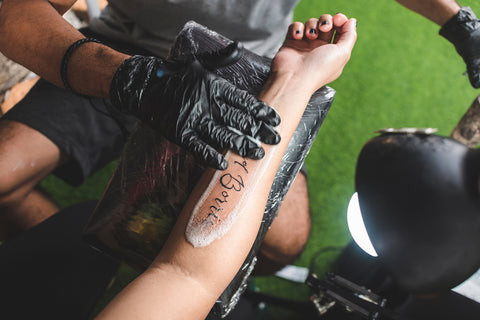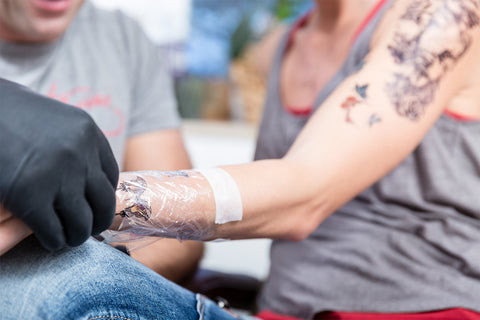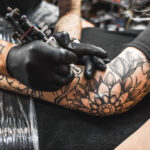Forearm tattoos are often touted as a relatively less painful option compared to other areas of the body, but the real question is: how much does a forearm tattoo really hurt? At tattooat.com, we believe everyone deserves a comfortable and enjoyable tattoo experience. This guide dives deep into the pain factor of forearm tattoos, offering insights, tips, and solutions to help you achieve the body art of your dreams with minimal discomfort. Whether you’re considering your first piece or adding to your collection, understanding the pain levels and how to manage them is key to a positive tattooing journey. Let’s explore forearm tattoo pain and discover how to make your next session a breeze, covering everything from pain management to aftercare, ensuring your tattoo journey is as smooth as possible.
1. Understanding Forearm Tattoo Pain: Debunking Myths
Is a forearm tattoo really less painful? Yes, forearm tattoos are generally considered less painful than tattoos on other body parts due to the presence of more muscle and fewer nerve endings compared to areas like ribs or ankles. However, pain is subjective, and individual experiences vary greatly.
The perception of pain during a tattoo session depends on several factors:
- Individual Pain Tolerance: Everyone experiences pain differently. What might be a minor sting for one person could be quite intense for another.
- Placement on the Forearm: Different areas of the forearm have varying levels of sensitivity.
- Tattoo Size and Complexity: Larger, more detailed tattoos require longer sessions, which can increase discomfort.
- Artist’s Technique: A skilled artist can minimize pain through efficient and gentle techniques.
- Mental State: Anxiety and stress can heighten pain perception.
It’s important to remember that the myth of pain-free tattoos is just that—a myth. While forearm tattoos may be less excruciating, some discomfort is to be expected. Understanding this and preparing accordingly can make a significant difference in your overall experience.
2. Outer Forearm Tattoos: A Gentler Introduction?
Is the outer forearm a good spot for those worried about pain? Absolutely, the outer forearm is often recommended as a less painful area for tattoos because it boasts a good layer of flesh and fewer nerve endings. This combination helps to cushion the tattooing process, reducing the intensity of pain signals.
The outer forearm’s pain level is generally considered low to moderate. Here’s why:
- Muscle and Flesh: The presence of ample muscle and flesh provides a buffer between the needle and the bone.
- Fewer Nerve Endings: Compared to more sensitive areas, the outer forearm has fewer nerve endings, minimizing pain signals sent to the brain.
- Accessibility: The flat, easily accessible surface makes it easier for the artist to work, potentially reducing the time spent on the tattoo.
However, there’s an exception. The elbow area on the outer forearm can be more painful due to thinner skin and proximity to bone. If you’re planning a design that extends to the elbow, be prepared for a more intense sensation. But don’t let that deter you! With the right preparation and pain management strategies, even elbow tattoos can be manageable.
3. Inner Forearm Tattoos: Navigating the Sensitivity
Is the inner forearm more sensitive than the outer forearm? Yes, the inner forearm tends to be more sensitive due to a higher concentration of nerve endings and thinner skin. While still considered less painful than some other areas of the body, it’s important to be aware of the potential for increased discomfort.
Here’s what to expect with inner forearm tattoos:
- More Nerve Endings: The inner forearm has a higher density of nerve endings, making it more sensitive to pain.
- Thinner Skin: The skin on the inner forearm is generally thinner, providing less cushioning against the needle.
- Proximity to the Wrist: Areas closer to the wrist can be particularly sensitive due to the presence of tendons and bones near the surface.
Like the outer forearm, the area around the elbow on the inner arm is also more sensitive due to thinner skin and more nerve endings. Additionally, this area experiences more movement, which can prolong the healing process. Some people even report a ticklish sensation mixed with pain in this region.
4. Sleeve Tattoos: Endurance and Pain Management
Are sleeve tattoos more painful due to their extensive coverage? Yes, sleeve tattoos, which cover the entire arm (or a significant portion thereof), are generally more painful than smaller tattoos due to the extensive coverage and longer sessions involved. Whether it’s a full sleeve encompassing the bicep and forearm or a partial sleeve focusing on one area, the duration and intensity can increase the overall pain experience.
Here’s why sleeve tattoos can be more challenging:
- Longer Sessions: Sleeve tattoos require multiple long sessions, which can lead to increased fatigue and heightened pain sensitivity.
- Varying Sensitivity: Sleeve tattoos often cover areas with different levels of sensitivity, from the fleshy outer forearm to the more sensitive inner arm and elbow regions.
- Skin Irritation: Prolonged tattooing can cause significant skin irritation and inflammation, adding to the discomfort.
- Multiple Sessions: While the arm has time to heal in-between sessions, that “new” tattoo pain is never fun.
Despite the potential for increased pain, sleeve tattoos offer incredible artistic possibilities. The key is to prepare adequately, manage pain effectively, and take breaks during sessions to minimize discomfort.
 Planning a Forearm Tattoo? Here’s What You Should Know
Planning a Forearm Tattoo? Here’s What You Should Know
5. Popular Forearm Tattoo Designs: Inspiration and Considerations
What are some popular forearm tattoo ideas, and how do they affect the pain level? Popular forearm tattoo designs range from simple quotes to intricate sleeves, each with its own pain considerations. Choosing a design that resonates with you is essential, but understanding how the design might impact the pain experience can help you prepare better.
Here are some popular forearm tattoo designs and their potential pain factors:
| Design | Description | Pain Considerations |
|---|---|---|
| Quote Tattoo | Meaningful quotes in various fonts and sizes. | Generally less painful due to smaller size and quicker completion. Bold designs may require more time, increasing discomfort. |
| Armband Tattoos | Designs that wrap around the forearm like a bracelet, including geometric shapes, tribal patterns, and nature-inspired motifs. | Pain level varies depending on the width and complexity of the design. Areas closer to the wrist or elbow may be more sensitive. |
| Flower Tattoo | Versatile designs featuring various flowers in different styles, from simple outlines to detailed watercolor pieces. | Pain depends on the size, detail, and color saturation. Larger, more detailed pieces require longer sessions, leading to increased discomfort. |
| Smaller Designs | Small, minimalist designs like arrows, trees, or symbols. | Typically less painful due to their small size and quick completion. |
| Cover-Up Tattoo | Designs that cover up existing tattoos. | Can be more painful due to the need for darker inks and more extensive work to effectively conceal the old tattoo. May also require multiple sessions. |
Remember to discuss your design ideas with your tattoo artist. They can provide valuable insights into pain management and suggest modifications to minimize discomfort without compromising the integrity of the design. Tattooat.com offers a vast array of designs to spark inspiration, so head over and find the perfect one for you.
6. Preparing for Your Forearm Tattoo: A Step-by-Step Guide
How can I prepare for a forearm tattoo to minimize pain and ensure a smooth session? Proper preparation is key to a more comfortable and successful tattoo experience. By taking the right steps before, during, and after your session, you can significantly reduce pain and promote optimal healing.
Here’s a step-by-step guide to preparing for your forearm tattoo:
- Choose a Reputable Artist and Studio: Research and select a skilled tattoo artist with a clean and professional studio. Read reviews, check portfolios, and ensure they follow strict hygiene practices. tattooat.com can help you find reputable artists and studios in your area.
- Consult with Your Artist: Discuss your design, placement, and any concerns you have about pain. Your artist can provide valuable advice and adjust the design as needed.
- Stay Hydrated: Drink plenty of water in the days leading up to your appointment. Hydrated skin is more resilient and less prone to irritation.
- Eat a Good Meal: Have a substantial meal before your session to maintain stable blood sugar levels and prevent dizziness.
- Avoid Alcohol and Caffeine: These substances can thin your blood and increase sensitivity to pain.
- Get a Good Night’s Sleep: Being well-rested can help you better manage pain and stress.
- Wear Comfortable Clothing: Choose loose-fitting clothing that allows easy access to your forearm.
- Clean and Shave the Area: Ensure the area to be tattooed is clean and free of hair. Shave the area gently the day before or the day of your appointment.
- Consider Topical Anesthetics: Discuss the use of numbing creams or gels with your artist. These can significantly reduce pain during the session.
- Relax and Stay Positive: Practice relaxation techniques like deep breathing or meditation to calm your nerves and reduce anxiety.
By following these steps, you can create a more relaxed and comfortable environment for your tattoo session.
7. Managing Pain During Your Forearm Tattoo: Techniques and Products
How can I manage pain during a forearm tattoo session? Managing pain during your tattoo session is crucial for a positive experience. Fortunately, several techniques and products can help minimize discomfort and keep you relaxed.
Here are some effective pain management strategies:
- Topical Anesthetics: Numbing creams and gels containing lidocaine can significantly reduce pain by blocking nerve signals. Apply a thick layer to the area an hour before your session, following your artist’s instructions. HUSH Numbing Gel and Numbing Cream are popular choices known for their effectiveness.
- Breathing Techniques: Practice deep, controlled breathing to help calm your nervous system and reduce pain perception. Inhale deeply through your nose and exhale slowly through your mouth.
- Distraction: Engage in activities that distract you from the pain, such as listening to music, watching a movie, or talking to your artist.
- Take Breaks: Don’t hesitate to ask for breaks during longer sessions. Taking a few minutes to stretch, walk around, and refocus can make a big difference.
- Communicate with Your Artist: Let your artist know if you’re experiencing too much pain. They can adjust their technique or take more frequent breaks.
- Stay Hydrated and Eat Snacks: Keep your blood sugar levels stable by staying hydrated and snacking on nutritious foods during the session.
- Relax Your Muscles: Consciously relax your arm and shoulder muscles to reduce tension and discomfort.
Remember, open communication with your artist is key. They are there to support you and ensure you have the best possible experience.
8. Forearm Tattoo Aftercare: Ensuring Proper Healing
What does forearm tattoo aftercare involve, and how does it affect the healing process? Proper aftercare is essential for ensuring your forearm tattoo heals correctly and remains vibrant for years to come. Neglecting aftercare can lead to infections, fading, and other complications.
Here’s a comprehensive guide to forearm tattoo aftercare:
- Follow Your Artist’s Instructions: Your tattoo artist will provide specific aftercare instructions tailored to your tattoo and skin type. Follow these instructions carefully.
- Keep It Clean: Gently wash the tattooed area with mild, fragrance-free soap and warm water two to three times a day. Use your fingertips to avoid harsh scrubbing. HUSH CBD Foam Soap is an excellent choice for its soothing and cleansing properties.
- Pat Dry: After washing, gently pat the area dry with a clean paper towel. Avoid using cloth towels, which can harbor bacteria.
- Apply a Healing Balm: Apply a thin layer of a healing balm or ointment to keep the tattoo moisturized. HUSH Healing Balm is formulated with CBD, shea butter, and mango seed butter to promote healing and reduce inflammation.
- Avoid Sun Exposure: Protect your new tattoo from direct sunlight by wearing loose-fitting clothing or applying sunscreen after it has fully healed.
- Don’t Pick or Scratch: Avoid picking, scratching, or rubbing the tattoo, as this can damage the skin and lead to infection.
- Stay Hydrated: Continue to drink plenty of water to keep your skin hydrated and promote healing.
- Avoid Soaking: Avoid prolonged soaking in water, such as swimming or taking baths, until the tattoo is fully healed.
- Wear Loose Clothing: Wear loose-fitting clothing to avoid friction and irritation.
- Monitor for Signs of Infection: Watch for signs of infection, such as redness, swelling, excessive pain, or pus. If you notice any of these symptoms, contact your tattoo artist or a healthcare professional immediately.
Proper aftercare is an investment in the longevity and beauty of your tattoo. By following these guidelines, you can ensure your forearm tattoo heals properly and remains a stunning piece of art for years to come.
 Planning a Forearm Tattoo? Here’s What You Should Know
Planning a Forearm Tattoo? Here’s What You Should Know
9. The Role of Topical Anesthetics: HUSH Products
How do topical anesthetics like HUSH Numbing Gel and Cream work to reduce tattoo pain? Topical anesthetics play a significant role in reducing tattoo pain by temporarily numbing the skin and blocking nerve signals. Products like HUSH Numbing Gel and Numbing Cream are designed to provide maximum pain relief without compromising the integrity of the tattooing process.
Here’s how HUSH products work:
- Lidocaine: Both HUSH Numbing Gel and Cream contain lidocaine, a powerful local anesthetic that numbs the skin by blocking nerve signals. This reduces the sensation of pain during the tattoo session. According to studies, lidocaine is effective in reducing pain when applied topically.
- Numbing Gel: The water-based gel formula allows for quick absorption and targeted pain relief. It also contains soothing ingredients like green tea, chamomile, calendula, and aloe leaf extracts to support skin health and reduce irritation.
- Numbing Cream: The cream formula is ideal for sensitive skin and provides long-lasting pain relief. It is paraben-free and does not contain menthol, making it suitable for those with menthol sensitivities.
- Application: Apply a thick layer of the chosen product to the area one hour before your session. Wrap the area in plastic wrap to enhance absorption and effectiveness.
- Benefits: HUSH products not only reduce pain but also help to minimize flinching and anxiety, allowing your artist to work more efficiently and create a better tattoo.
By incorporating topical anesthetics into your tattoo preparation, you can significantly reduce pain and enjoy a more comfortable and relaxed experience.
10. Debunking Myths: Pain-Free Tattoos?
Is it possible to have a completely pain-free forearm tattoo experience? While the idea of a completely pain-free tattoo is appealing, it’s important to acknowledge that some level of discomfort is almost always present. However, with the right strategies and products, you can significantly minimize pain and make the experience much more manageable.
Here are some common myths about pain-free tattoos:
- Myth 1: Forearm tattoos are completely painless. While forearm tattoos are generally less painful than other areas, they are not entirely pain-free.
- Myth 2: Numbing creams eliminate all pain. Numbing creams can significantly reduce pain, but they may not eliminate it entirely. Some people may still experience mild discomfort.
- Myth 3: Only certain people experience tattoo pain. Everyone experiences tattoo pain differently, but pain is a common part of the process.
- Myth 4: You can completely avoid pain with the right mindset. While a positive mindset can help, it cannot eliminate physical pain.
- Myth 5: All topical anesthetics are the same. Different topical anesthetics have varying levels of effectiveness and ingredients. It’s important to choose a reputable product like HUSH Numbing Gel or Cream.
The reality is that tattoo pain is subjective and varies from person to person. By understanding this and preparing with effective pain management techniques, you can make your forearm tattoo experience as comfortable as possible.
FAQ: Addressing Your Forearm Tattoo Pain Concerns
1. How much does a forearm tattoo hurt compared to other locations?
Forearm tattoos generally hurt less than areas with more nerve endings or less fat, like the ribs or ankles.
2. Does the inner or outer forearm hurt more for a tattoo?
The inner forearm is typically more sensitive due to thinner skin and more nerve endings.
3. Can I use numbing cream for a forearm tattoo?
Yes, numbing creams like HUSH Numbing Cream are effective for reducing pain during a forearm tattoo.
4. How long does the pain last after getting a forearm tattoo?
The initial pain subsides within a few hours, but soreness may last for a few days.
5. What can I do to prepare for a less painful forearm tattoo?
Stay hydrated, avoid alcohol, get good sleep, and use a numbing cream.
6. Are sleeve tattoos on the forearm more painful than smaller tattoos?
Yes, because they cover a larger area and take longer to complete.
7. How do I care for my forearm tattoo to minimize pain during healing?
Keep it clean, moisturized, and protected from the sun.
8. Is it normal for my forearm tattoo to itch during the healing process?
Yes, itching is a common part of the healing process. Avoid scratching it.
9. Can the design of my forearm tattoo affect the pain level?
Yes, more detailed designs require longer sessions and may be more painful.
10. When should I consult a doctor about pain after getting a forearm tattoo?
If you experience excessive pain, redness, swelling, or signs of infection.
Getting a forearm tattoo doesn’t have to be a daunting experience filled with dread. Armed with the right knowledge, preparation, and pain management strategies, you can confidently embark on your tattoo journey and achieve the stunning body art you’ve always dreamed of.
Ready to explore a world of tattoo inspiration, connect with talented artists, and learn more about the art of tattooing? Visit tattooat.com today and discover everything you need for a smooth and fulfilling tattoo experience! Dive into our extensive collection of designs, find the perfect artist for your style, and read our in-depth guides on tattoo aftercare and pain management. Your dream tattoo awaits!

